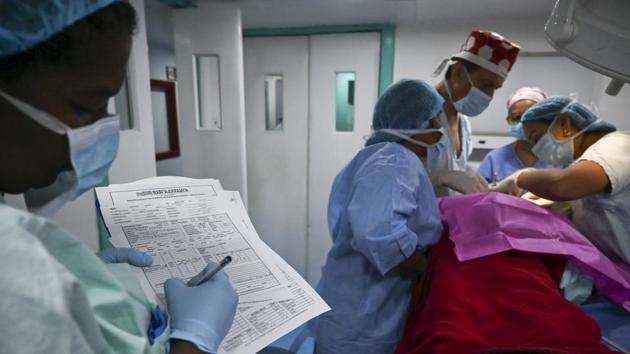Photos: Hospital ship plies Colombia’s turbulent Pacific coast
Updated On May 10, 2019 05:54 PM IST
In Colombia, the hospital ship named San Raffaele sails along the Colombian Pacific coast to reach the most indigenous vulnerable communities and people who have not been included in the state health programmes. The ship features 25 doctors and nurses, some paid and some volunteer, including a gynecologist, a dentist, a pediatrician and a psychologist. A crew of seven operates the ship itself.
1 / 12

Updated on May 10, 2019 05:54 PM IST
Locals get on a boat to the hospital ship San Raffaele, in Docordo municipality, on the banks of San Juan river, Colombia. The hospital ship "San Raffaele" is a vessel turned into a traditional hospital, which sails along the Colombian Pacific coast to reach the most vulnerable communities --as the indigenous and Afro-Colombian minorities- and those people not included in state health programmes. (Raul Arboleda / AFP)
2 / 12

Updated on May 10, 2019 05:54 PM IST
Colombian natives of the Wounaan ethnic group stand at their house on the banks of the San Juan river. For hundreds of miles along Colombia’s Pacific coast, with its thick, lush jungle, there are no hospitals, and medics and medicine are rare. And so, the San Raffaele hospital ship, when it arrives, is treated like a ghostly miracle by the poor indigenous and Afro-Caribbean communities that dot this violent region. (Raul Arboleda / AFP)
3 / 12

Updated on May 10, 2019 05:54 PM IST
“The proper medicines are not coming in. They are too expensive,” says Yenny Cardenas, weaving a basket as she waits in her hut, which is built on stilts over the riverbank. Its roof thrums under heavy rain. She is waiting to board a skiff that will speed her across to the ship with her baby boy, her fifth child. She’s worried about his skin which, for months now, has been covered in sores. (Raul Arboleda / AFP)
4 / 12

Updated on May 10, 2019 05:54 PM IST
Colombian doctor and teacher Oscar Arley Gomez (R) speaks with locals before the arrival of the hospital ship. The area has just one medical dispensary, supplying 16,000 people. On the other bank is the wharf at Docordo, a majority Afro-Colombian town lost in the country’s poorest department, Choco -- where nearly 50 percent of the population live in extreme poverty, compared to 17 percent nationally. (Raul Arboleda / AFP)
5 / 12

Updated on May 10, 2019 05:54 PM IST
Bearing a white cross on its hull, it’s anchored mid-river, as if honouring its neutrality between these two neighbouring communities -- indigenous and Afro-Colombian -- which do not mix. Another sign -- featuring a machine gun with a ‘X’ over it -- warns that carrying firearms on board is prohibited. (Raul Arboleda / AFP)
6 / 12

Updated on May 10, 2019 05:54 PM IST
People line up, waiting their turn to be seen by the doctors and nurses. Some have their hands on their stomachs, some are bent over with age, some are young pregnant women with kids in tow -- all wait to tell their woes and receive free treatment. “Some of these people have not been able to see a doctor for years,” said Ana Lucia Lopez, 51, co-founder of the Monte Tabor Foundation, which operates this 80-foot hospital. (Raul Arboleda / AFP)
7 / 12

Updated on May 10, 2019 05:54 PM IST
Hailing from the port of Buenaventura, the ship has been plying the 1,300 kilometers length of Colombia’s Pacific coast since 2009, from the Panamanian border in the north to Ecuador in the south. It features 25 doctors and nurses, some paid and some volunteer, including a gynecologist, a dentist, a paediatrician and a psychologist. A crew of seven operates the ship. (Raul Arboleda / AFP)
8 / 12

Updated on May 10, 2019 05:54 PM IST
Diego Posso and Ana Lucia Lopez speak with doctors in the hospital ship. “Already over the past few years, 65,000 people have been seen and more than 4,000 operations have been carried out,” said Posso, 49, a paramedic expert in trauma and the founding president of Monte Tabor. Posso himself designed the ship with help from a naval architect. (Raul Arboleda / AFP)
9 / 12

Updated on May 10, 2019 05:54 PM IST
There is no let-up for paediatric surgeon Carlos Melo, 55. He follows surgery with surgery, and not only for children. “These people have nothing. Everything is so far away. We’re talking six, eight hours by canoe. There are no doctors,” said Melo, a pioneer of minimally invasive abdominal surgery known as laparoscopy, who has volunteered on the ship for the past five years. (Raul Arboleda / AFP)
10 / 12

Updated on May 10, 2019 05:54 PM IST
The local communities had to negotiate with several armed groups to ensure safe passage for the San Raffaele. Gunmen have held sway here for decades -- from National Liberation Army rebels to narco-trafficking gangs like the feared Gulf Clan -- effectively making it a war zone. “Sometimes it has been difficult to reach the villages where there have been clashes, bombs,” said Lopez. (Raul Arboleda / AFP)
11 / 12

Updated on May 10, 2019 05:54 PM IST
At the end of the corridor, in a small pastel-coloured room, Maria Isabel Lozano examines Carderas’ baby and diagnoses a skin infection. It’s a common diagnosis here, where communities are exposed to the polluted waters of the San Juan. The pollution is caused by chemical waste from cocaine production and run-off water from illegal mining. (Raul Arboleda / AFP)
12 / 12

Updated on May 10, 2019 05:54 PM IST



